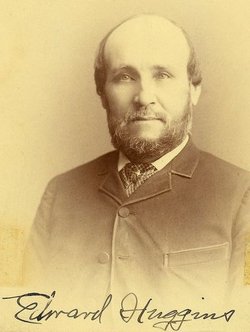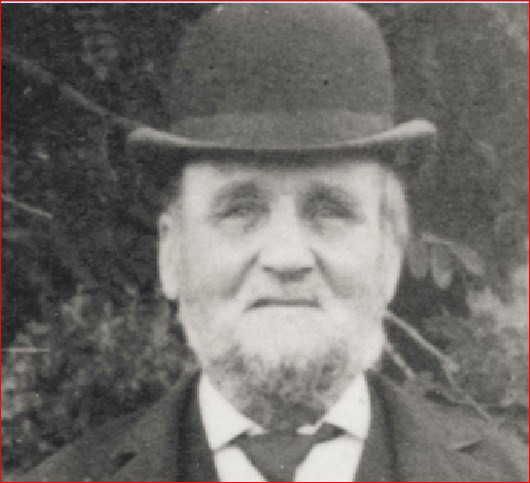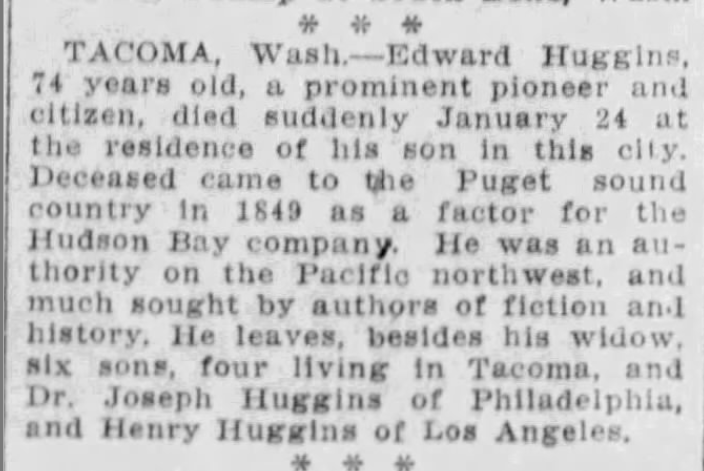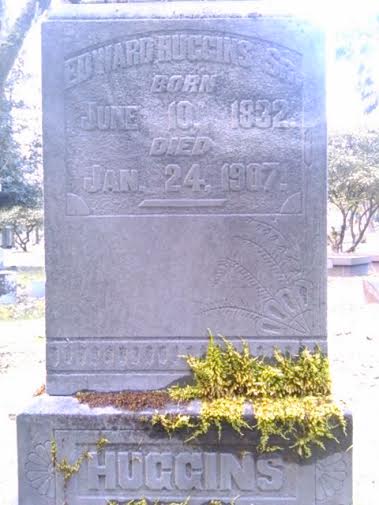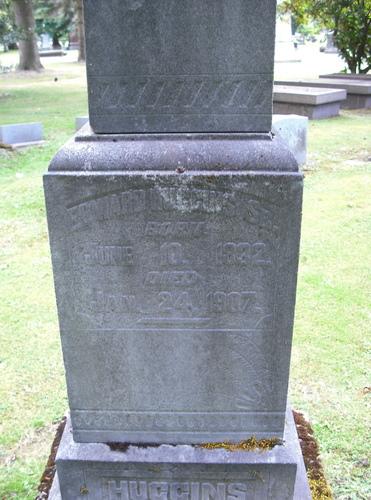Edward Huggins: Hudson's Bay Company Employee, Homestead Farmer, and Early Historian
By Drew W. Crooks
Many interesting people have lived in the area now known as DuPont, Washington. One remarkable inhabitant was Edward Huggins. During much of the nineteenth century and part of the twentieth century, Edward successfully served in the roles of Hudson's Bay Company employee, homestead farmer and early historian.
The early life of Edward Huggins was shaped by his experiences in England. He was born on June 10, 1832 in London's borough of Southwark on the south side of the Thames River. This area contained many places mentioned in the novels of Charles Dickens. Edward later wrote about his schooling:
"I went for seven years to St. Olave's Free Government School, it was called Queen Elizabeth's Grammar school, situated in the parish of Bermondsey, London, and not very far from the great terminus of the South Eastern Railroad. It is a good school, and its compliment of scholars is 300 (or was then."
When he was 14 or 15, Edward took a job at a ships broker's office situated on Grace Church Street in London. This business was located close to the Hudson's Bay Company office on Frenchchurch Street. Apparently, the young Huggins must not have been satisfied with his station in England. In 1849 he took the drastic step of joining the Hudson's Bay Company, the British fur trading corporation with operations in what is now Canada and the Pacific Northwest.
The 17-year-old Edward left England and traveled to the Northwest coast on the HBC ship, Norman Morrison. He never returned to the land of his birth. After arriving at Fort Victoria on Vancouver Island, Huggins soon was transferred by the Hudson's Bay Company to Fort Nisqually in southern Puget Sound. Established near Sequalitchew Creek on land that is now part of DuPont, this HBC trading post in the mid-nineteenth century brought together company employees: Native Americans and American settlers.
Huggins would spend the next 20 years of his life working for the Hudson's Bay Company either at Fort Nisqually or a nearby satellite farm. During this time he labored as a clerk and bookkeeper. Much of his time at the Fort was spent handling the essential trade shop, where British goods were exchanged for furs and other products. During this period he came to be regarded as the right-hand man of Dr. Tolmie, the HBC officer who oversaw Fort Nisqually operations from 1843 to 1859.
During the difficult times of the Puget Sound Indian War (1855-1856), Huggins temporarily moved from the Fort to the farming outstation of Muck located on Muck Creek, a tributary of the Nisqually River. From the Muck station he supervised the network of satellite farms scattered between the Puyallup and Nisqually Rivers. Technically the farms were run by the Puget Sound's Agricultural Company (PSAC), a subsidiary of the Hudson's Bay Company.
Edward Huggins, in some of his reminiscences, described his experiences at Muck:
"There was a large log house on the place which stood on the south side of Muck creek and a half a mile from the timber. Myself and the hands, some twenty in number, lived in this house during the war... I pastured about two thousand sheep from Muck house which were herded by white men and Kanakas (Hawaiians). I also had a large lot of sheep, cattle, and horses at other stations on these Plains, and for two years, I would make weekly horseback trips around the stations, a distance of thirty or forty miles and not set eyes upon a human being except our own men, and now and then parties of (American settler) volunteers who were out scouting for Indians."
On October 21, 1857, Edward married Letitia Work at Fort Nisqually. Letitia came from a distinguished fur trade family background. Her parents were John Work, a leading HBC officer, and Josette Lagace Work. Several of Letitia's sisters became the wives of individuals high in the hierarchy of the Hudson's Bay Company. Her sister, Jane, married Dr. Tolmie. Edward and Letitia had a long marriage and numerous children.
By the time of his marriage, he was widely recognized as a capable manager. He took charge of Fort Nisqually in 1859 when Dr. Tolmie was transferred to Fort Victoria. For the next 11 years Edward oversaw the trading post in the southern Puget Sound area. Then in 1869 the U.S. government purchased the possessory rights and claims of the HBC/PSAC south of the international border at the 49th degree parallel. Company operations moved north to British territory. Consequently, Fort Nisqually closed in 1870.
The Hudson's Bay Company proposed to move Huggins (and his family) to Fort Kamloops in the rugged interior of British Columbia. This was not an attractive proposal to the Huggins family. They said "no." Edward retired from the company. It must have been a momentous step for him after so many years of loyal service to the British corporation.
The Huggins family became homestead farmers. They took as a claim the old Fort Nisqually site. For a time he operated a trade shop at his farm, but this was closed due to declining fur supplies and lack of British goods. At the same time Huggins developed an extensive farm. In time he came to own about 1,000 acres of land.
Faithful to his HBC training, Edward continued keeping detailed records of his business activities, including journals. These journals are now preserved at the Washington State Historical Society Research Center in Tacoma. The documents contain detailed information about late nineteenth century farming practices.
Edward Huggins did not live an isolated life at his farm. Officially an American citizen since 1870, he became involved in local political affairs as a member of the Republican party. For three terms he served in the 1870s and 1880s as a member of the Pierce County Board of Commissioners, even for a time as its chairman. Then from 1886 to 1890 he held the position of Pierce County Auditor. Edward was also associated with the National Commerce Bank of Tacoma as a director and vice president.
The last phase of Huggins' life involved much change. Due to health concerns and a wish to be with their family, he and his wife felt that it was best to leave the old homestead and move to Tacoma. They sold the Fort Nisqually farm to the DuPont Company in 1906 for $43,000. This company was interested in constructing an explosives plant in the region.
As can be expected, it was difficult for Edward and Letitia Huggins to depart from their old home. Edward wrote in a 1906 letter to his friend, Clarence Bagley, about the situation:
"I am troubled about my wife. She, I fear, doesn't like the idea of leaving the old place, altho' she's willing, and knows that she couldn't live here in such close neighborhood with an explosive factory, which will be (so 'tis said) the most extensive in size in the United States. 'Tis not at all surprising that she'd feel regret at leaving the place where she has lived since she was 20 yr's of age. She came to Mrs. W. F. Tolmie (her sister) when her first (Mrs. Tolmie's) child was born (in 1851) and made several visits (crossed the straits in a canoe seven times) before coming here to live permanently, so you see, it isn't at all surprising that she feels regret at leaving, when we are both looking forward to soon being called to make the great move, and that adds to our feeling of regret."
The elderly couple moved to Tacoma in November 1906. They stayed at the home of their son, David, while a new house was being completed for them on Ainsworth Street. Edward never lived to see the house finished. He became ill and died on January 24, 1907. Letitia Huggins passed away on September 12, 1910. Both are buried in the old Tacoma Cemetery.
Though Edward Huggins played important roles as HBC employee and homestead farmer, he also served as an early historian. Recognizing the historical significance of Fort Nisqually for the development of the region, Edward wished to preserve knowledge of the trading post's history. Consequently he wrote a number of historical essays. Some of these essays were published in newspapers during his lifetime. Many were reprinted years later in "Reminiscences of Puget Sound," by Edward Huggins, a book edited by Gary Fuller Reese of the Tacoma Public Library.
In addition, Edward Huggins wrote much about Fort Nisqually history in various letters. This correspondence was carefully transcribed by Joseph Huntsman in the late 20th century, and published as "Edward Huggins' Correspondence Outwards, 1862-1907." Huggins' historical writing are a wonderful legacy that, through vivid characterizations and colorful stories, helps bring to life for readers the fascinating story of Fort Nisqually.
Edward Huggins: Hudson's Bay Company Employee, Homestead Farmer, and Early Historian
By Drew W. Crooks
Many interesting people have lived in the area now known as DuPont, Washington. One remarkable inhabitant was Edward Huggins. During much of the nineteenth century and part of the twentieth century, Edward successfully served in the roles of Hudson's Bay Company employee, homestead farmer and early historian.
The early life of Edward Huggins was shaped by his experiences in England. He was born on June 10, 1832 in London's borough of Southwark on the south side of the Thames River. This area contained many places mentioned in the novels of Charles Dickens. Edward later wrote about his schooling:
"I went for seven years to St. Olave's Free Government School, it was called Queen Elizabeth's Grammar school, situated in the parish of Bermondsey, London, and not very far from the great terminus of the South Eastern Railroad. It is a good school, and its compliment of scholars is 300 (or was then."
When he was 14 or 15, Edward took a job at a ships broker's office situated on Grace Church Street in London. This business was located close to the Hudson's Bay Company office on Frenchchurch Street. Apparently, the young Huggins must not have been satisfied with his station in England. In 1849 he took the drastic step of joining the Hudson's Bay Company, the British fur trading corporation with operations in what is now Canada and the Pacific Northwest.
The 17-year-old Edward left England and traveled to the Northwest coast on the HBC ship, Norman Morrison. He never returned to the land of his birth. After arriving at Fort Victoria on Vancouver Island, Huggins soon was transferred by the Hudson's Bay Company to Fort Nisqually in southern Puget Sound. Established near Sequalitchew Creek on land that is now part of DuPont, this HBC trading post in the mid-nineteenth century brought together company employees: Native Americans and American settlers.
Huggins would spend the next 20 years of his life working for the Hudson's Bay Company either at Fort Nisqually or a nearby satellite farm. During this time he labored as a clerk and bookkeeper. Much of his time at the Fort was spent handling the essential trade shop, where British goods were exchanged for furs and other products. During this period he came to be regarded as the right-hand man of Dr. Tolmie, the HBC officer who oversaw Fort Nisqually operations from 1843 to 1859.
During the difficult times of the Puget Sound Indian War (1855-1856), Huggins temporarily moved from the Fort to the farming outstation of Muck located on Muck Creek, a tributary of the Nisqually River. From the Muck station he supervised the network of satellite farms scattered between the Puyallup and Nisqually Rivers. Technically the farms were run by the Puget Sound's Agricultural Company (PSAC), a subsidiary of the Hudson's Bay Company.
Edward Huggins, in some of his reminiscences, described his experiences at Muck:
"There was a large log house on the place which stood on the south side of Muck creek and a half a mile from the timber. Myself and the hands, some twenty in number, lived in this house during the war... I pastured about two thousand sheep from Muck house which were herded by white men and Kanakas (Hawaiians). I also had a large lot of sheep, cattle, and horses at other stations on these Plains, and for two years, I would make weekly horseback trips around the stations, a distance of thirty or forty miles and not set eyes upon a human being except our own men, and now and then parties of (American settler) volunteers who were out scouting for Indians."
On October 21, 1857, Edward married Letitia Work at Fort Nisqually. Letitia came from a distinguished fur trade family background. Her parents were John Work, a leading HBC officer, and Josette Lagace Work. Several of Letitia's sisters became the wives of individuals high in the hierarchy of the Hudson's Bay Company. Her sister, Jane, married Dr. Tolmie. Edward and Letitia had a long marriage and numerous children.
By the time of his marriage, he was widely recognized as a capable manager. He took charge of Fort Nisqually in 1859 when Dr. Tolmie was transferred to Fort Victoria. For the next 11 years Edward oversaw the trading post in the southern Puget Sound area. Then in 1869 the U.S. government purchased the possessory rights and claims of the HBC/PSAC south of the international border at the 49th degree parallel. Company operations moved north to British territory. Consequently, Fort Nisqually closed in 1870.
The Hudson's Bay Company proposed to move Huggins (and his family) to Fort Kamloops in the rugged interior of British Columbia. This was not an attractive proposal to the Huggins family. They said "no." Edward retired from the company. It must have been a momentous step for him after so many years of loyal service to the British corporation.
The Huggins family became homestead farmers. They took as a claim the old Fort Nisqually site. For a time he operated a trade shop at his farm, but this was closed due to declining fur supplies and lack of British goods. At the same time Huggins developed an extensive farm. In time he came to own about 1,000 acres of land.
Faithful to his HBC training, Edward continued keeping detailed records of his business activities, including journals. These journals are now preserved at the Washington State Historical Society Research Center in Tacoma. The documents contain detailed information about late nineteenth century farming practices.
Edward Huggins did not live an isolated life at his farm. Officially an American citizen since 1870, he became involved in local political affairs as a member of the Republican party. For three terms he served in the 1870s and 1880s as a member of the Pierce County Board of Commissioners, even for a time as its chairman. Then from 1886 to 1890 he held the position of Pierce County Auditor. Edward was also associated with the National Commerce Bank of Tacoma as a director and vice president.
The last phase of Huggins' life involved much change. Due to health concerns and a wish to be with their family, he and his wife felt that it was best to leave the old homestead and move to Tacoma. They sold the Fort Nisqually farm to the DuPont Company in 1906 for $43,000. This company was interested in constructing an explosives plant in the region.
As can be expected, it was difficult for Edward and Letitia Huggins to depart from their old home. Edward wrote in a 1906 letter to his friend, Clarence Bagley, about the situation:
"I am troubled about my wife. She, I fear, doesn't like the idea of leaving the old place, altho' she's willing, and knows that she couldn't live here in such close neighborhood with an explosive factory, which will be (so 'tis said) the most extensive in size in the United States. 'Tis not at all surprising that she'd feel regret at leaving the place where she has lived since she was 20 yr's of age. She came to Mrs. W. F. Tolmie (her sister) when her first (Mrs. Tolmie's) child was born (in 1851) and made several visits (crossed the straits in a canoe seven times) before coming here to live permanently, so you see, it isn't at all surprising that she feels regret at leaving, when we are both looking forward to soon being called to make the great move, and that adds to our feeling of regret."
The elderly couple moved to Tacoma in November 1906. They stayed at the home of their son, David, while a new house was being completed for them on Ainsworth Street. Edward never lived to see the house finished. He became ill and died on January 24, 1907. Letitia Huggins passed away on September 12, 1910. Both are buried in the old Tacoma Cemetery.
Though Edward Huggins played important roles as HBC employee and homestead farmer, he also served as an early historian. Recognizing the historical significance of Fort Nisqually for the development of the region, Edward wished to preserve knowledge of the trading post's history. Consequently he wrote a number of historical essays. Some of these essays were published in newspapers during his lifetime. Many were reprinted years later in "Reminiscences of Puget Sound," by Edward Huggins, a book edited by Gary Fuller Reese of the Tacoma Public Library.
In addition, Edward Huggins wrote much about Fort Nisqually history in various letters. This correspondence was carefully transcribed by Joseph Huntsman in the late 20th century, and published as "Edward Huggins' Correspondence Outwards, 1862-1907." Huggins' historical writing are a wonderful legacy that, through vivid characterizations and colorful stories, helps bring to life for readers the fascinating story of Fort Nisqually.
Family Members
Sponsored by Ancestry
Advertisement
Advertisement
